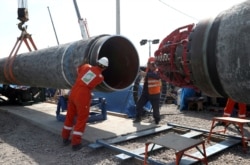On March 23, the Russian Embassy in the U.K. tweeted a quote from Russian President Vladimir Putin.
“The so-called collective West does not need a strong and sovereign Russia, and will not forgive us our independent policy and standing up for our national interests,” the quote reads. “It is trying to divide our society. It’s aim is to destroy Russia.”
In fact, that is false. For decades after the fall of the Soviet Union in 1991 and the end of the Cold War, the West has not only done much to help Russia, but also turned a blind eye to numerous Russian acts of aggression before the new Ukraine war.
Here is just a small sample of the things the United States has done to help and court Russia, from a U.S. State Department archive covering the years 1991 to 2009.
- In January 1992, the U.S. authorized $645 million in humanitarian aid to the newly independent republics of the former Soviet Union.
- That same month, Boris Yeltsin made his first visit to the United States as Russian president, during which he and then-U.S. president George H.W. Bush negotiated mutual arms reduction. Bush agreed to support Russia’s case for assistance from the International Monetary Fund and the World Bank. They issued a joint declaration stating that the United States and the Russian Federation were not enemies.
- In February 1992, the U.S. military’s Operation Provide Hope delivered medicine and medical equipment to all of the former Soviet republics, including Russia.
At the same time, the West did little while Yeltsin was in power and Russia bullied Georgia and Moldova. Russian forces played a key role in helping pro-Kremlin separatist movements defeat the legitimate governments in those countries.
These “frozen conflicts,” as they came to be known, continue to this day. In 2008, a Russian-backed upsurge in separatist violence in Georgia was followed by direct Russian military intervention in that country.
In 1994-1996, Russia launched a brutal but unsuccessful war against separatist forces in Chechnya, which had declared de facto independence as the Chechen Republic of Ichkeria. The U.S., like most nations, did not recognize this breakaway territory.
Had the West truly wanted to destroy Russia, there was no better time to do so than the 1990s, when the country was wracked by economic instability, poverty and organized crime. Instead, the West continued to bail out Russia’s leaders despite rampant corruption and violence, and threats of violence toward Russia’s neighbors.
U.S. cooperation with and assistance to Russia did not end after Yeltsin handed the reins of power to Putin.
In 2000, then-U.S. President Bill Clinton went to Moscow and signed a number of agreements with the new Russian president. Among them was the first permanent joint Russian-U.S. military mission, which entailed monitoring space and missile launches globally. Clinton and his successor, George W. Bush, continued to meet with Putin and hammer out agreements on arms reduction, arms control and counter-terrorism.
Even after Russia’s five-day war against Georgia in 2008, the U.S. and European Union continued to do business with Russia. In early 2009, newly-inaugurated U.S. president Barack Obama announced a “reset” with Russia in hopes of improving bilateral relations, which had deteriorated. That was followed by large investments in Russia by U.S. corporations, including PepsiCo, which poured in $1 billion that year.
Meanwhile, Ukraine and Georgia, both of which were seeking NATO membership, were denied action plans to join the alliance. The push to deny NATO membership for Ukraine and Georgia was mainly led by France and Germany, and was largely due to concerns about provoking Russia.
Russia, in cooperation with several Western European countries, finished the Nord Stream I natural gas pipeline in 2012 to sell more of its gas to Europe. Construction on a second pipeline, Nord Stream 2, began in 2011, and was nearly ready to operate before Russia invaded Ukraine a month ago.
The list of investments in Russia, and joint projects between Western countries and Russia, could go on for pages.
So how did Russia repay the West for decades of patience and tolerance for malfeasance?
- In 2007, Russia launched a wave of cyberattacks on Estonia.
- As previously noted, Russia invaded Georgia in 2008. It later officially recognized the two breakaway regions in Georgia, Abkhazia and South Ossetia.
- In 2014, Russia occupied and annexed Ukraine’s Crimean peninsula and fomented a war in its eastern Donbas region. This was the first aggressive Russian action that met with a Western response, mainly in the form of economic sanctions.
- In 2016, Russia engaged in a campaign to interfere in the U.S. presidential election, which included the dissemination of disinformation via social media and cyberattacks.
- Also in 2016, Russia was accused of plotting a coup to overthrow the pro-Western government of Montenegro.
- In 2018, Russian agents attempted to assassinate Sergei Skripal in Salisbury, England, using a Russian military grade chemical nerve agent. One person was killed and three hospitalized as a result of this operation. (In 2006, Russian agents had poisoned the dissident former Russian intelligence operative Alexander Litvinenko with a radioactive substance in London. One of the men involved in that assassination went on to become a member of Russia’s parliament.)
- Multiple assassinations and attempted assassinations against Chechen dissidents in Europe and the Middle East have been linked to Russia.
This is only a partial list of provocations leading up to Russia’s latest escalation. In just a few weeks, Putin’s full-scale invasion has left thousands dead, millions displaced and multiple Ukrainian cities looking like they were once again in the Second World War.






